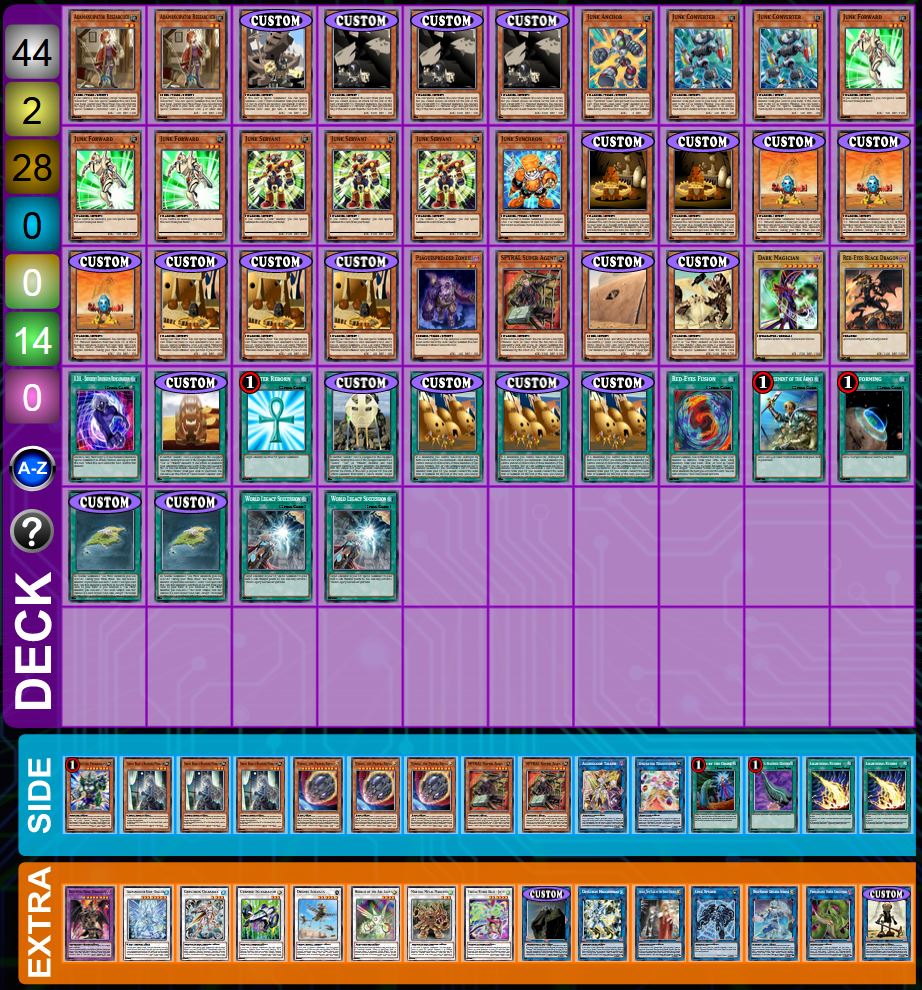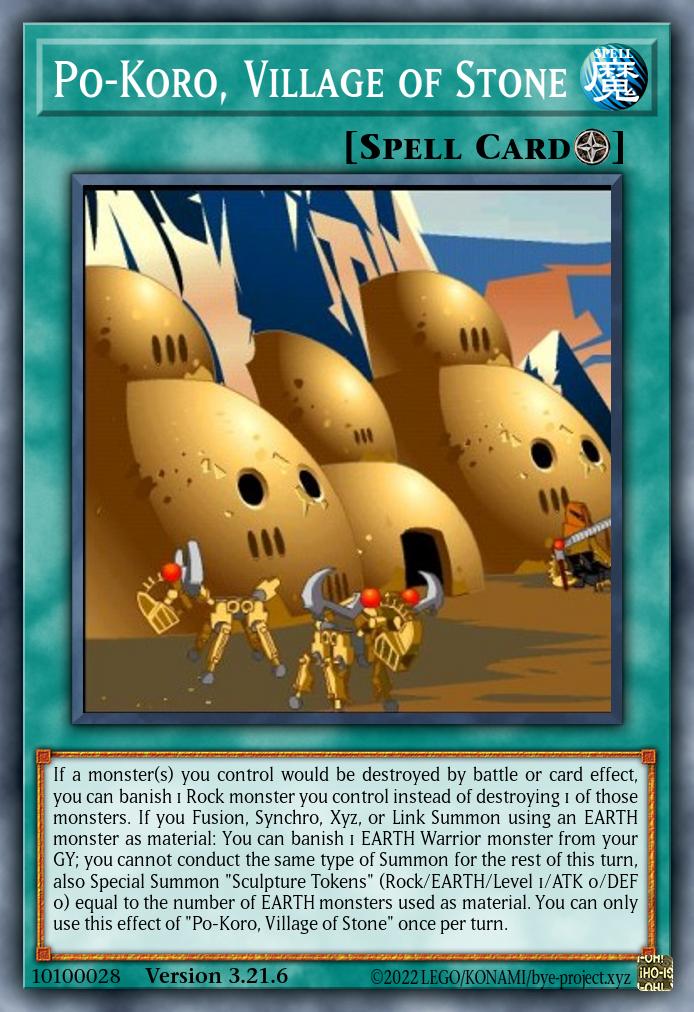
Po-Koro, Village of Stone
Field SpellIf a monster(s) you control would be destroyed by battle or card effect, you can banish 1 Rock monster you control instead of destroying 1 of those monsters. If you Fusion, Synchro, Xyz, or Link Summon using an EARTH monster as material: You can banish 1 EARTH Warrior monster from your GY; you cannot conduct the same type of Summon for the rest of this turn, also Special Summon “Sculpture Tokens” (Rock/EARTH/Level 1/ATK 0/DEF 0) equal to the number of EARTH monsters used as material. You can only use this effect of “Po-Koro, Village of Stone” once per turn.
Among the villages on Mata Nui, I’d say Po-Koro is pretty high up there in terms of memorable traits. There’s the sculptures made by the resident carvers, the busy trading going on at the bazaar, the entire sport of Koli, and of course that little plague it suffered under in MNOG. For my particular depiction of the Village of Stone, I chose to focus on the first two of these: Trading and carving. (Koli is something I plan to study in more detail when it transforms into Kolhii later down the line, since it gets much more focus in the story then, and the plague is a topic for BCOR.)
Let’s begin dissecting from the second effect, since that will usually be the first you use. This one represents carving, and what it does is, like most Koro stuff, mainly inspired by the corresponding MNOG2 principle. In Po-Koro’s case, that means “Creation”. My first association with this in game terms has alway been the various Extra Deck summons (literally putting your monsters together to CREATE a new one), but upon further reflection I realized that there is one mechanic that creates stuff more literally than any other, and that is Tokens – those straight up don’t exist in any form until an effect says they do. So by combining those two ideas, I ended up with an effect that summons Tokens whenever you Special Summon from the Extra Deck.
“But isn’t that basically just Linkross for every summoning method?”, you might ask, and you wouldn’t be exactly wrong. However, there are some extra hoops to jump through here that hopefully fix the glaring balance issues with the concept. Most trivially, this card is in the Main and not the Extra Deck, so it’s already less consistently accessible by default. Then there are also two points that prevent using it too generically: You need to banish an EARTH Warrior (the “sculptor”) from the GY as cost, and you only get Tokens (the “sculptures”) up to the number of EARTH materials (the “raw materials”) in the summon. Note especially the banishing, which is meant to directly discourage mixing the Po-Koro strategy with Onu-Koro (where the resource loop relies on not getting your monsters banished). They both revolve around the EARTH attribute since Stone doesn’t exist separately in Yugioh, so I made sure to strongly distinguish them by playstyles instead. The final restriction meant to prevent Linkross-tier combos even in those decks that can make Po-Koro work is that whichever summoning method you use to trigger it becomes entirely locked for the rest of the turn (as opposed to just restricting how the Tokens are used). So the moment you make your Tokens, you need to be ready to pivot to something else. In MNOG2 terms, this sensitive issue of timing matches up quite well to the Kolhii skill of Strategy that is derived from Creation. I was quite cautious making this effect since it’s so close to a recently banned card, and initially it was even more restricted, but test runs suggest the current level of power should be fine without causing any notable problems. As usual, feel free to prove me wrong.
The secondary effect (which is listed first because that seems to be the convention for continuous vs activated effects) allows you to save your monsters from destruction by “trading” fancy Rocks, as they do on the Po-Koro bazaar. This is possibly not the best trade since you have to go as far as banishing a monster to protect another, but the Tokens made by the other effect are conveniently Rocks and in their case banishing is no different from destroying, so the idea is to mainly use those. One pesky detail I only noticed after implementing the effect is that it does not protect from full boardwipes because you can’t banish a card already marked for destruction as replacement, but it’s still fairly handy regardless.
If you compare to the other Koro field spells, you might notice that this one is much less xenophobic: You need to play EARTH monsters, including at least one EARTH Warrior, to make it work, but it doesn’t punish you for playing anything else. This is because, in the name of creation and creativity, I wanted to leave it possible to put whatever you want into the Extra Deck, as long as you’re using at least two different summoning methods.
Those were some long-ass design notes, but to summarize and boil the strategy down to its essence: The idea of a Po-Koro deck is simply to spam as much as possible from the Extra Deck, building a board while combining at least two different summoning methods, and any Tokens left at the end of that can act as additional protection.
As usual, the village itself is only part of the equation here, so on to the rest. For example, what could you summon from the Extra Deck to make especially good use of Po-Koro’s effect?
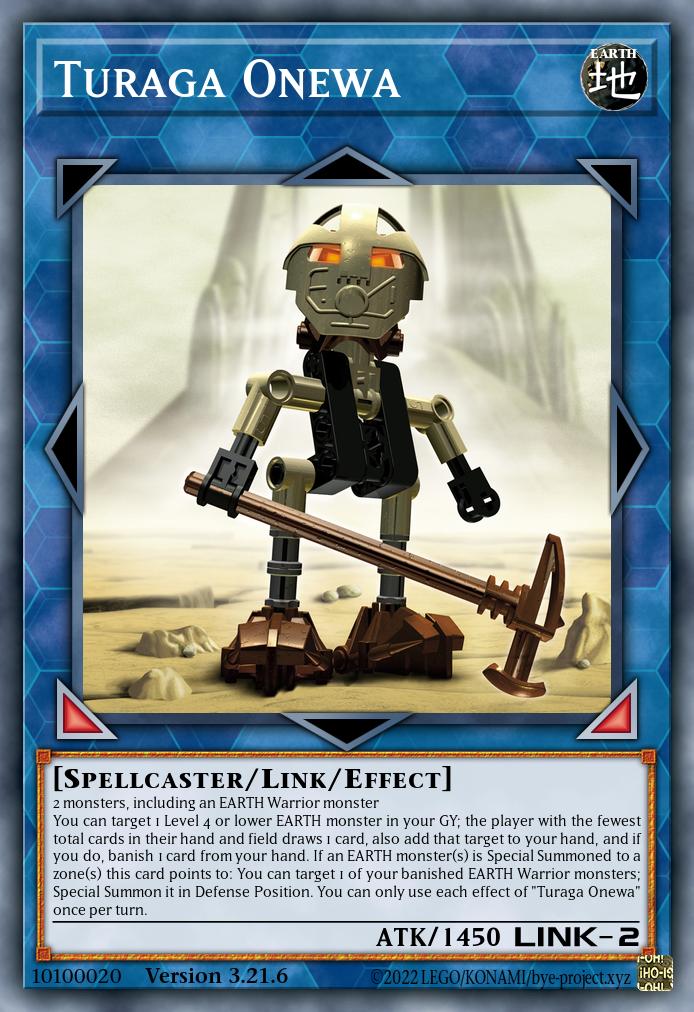
Turaga Onewa
Link Effect MonsterLink-2 [↙ ↘] | EARTH Spellcaster | ATK 14502 monsters, including an EARTH Warrior monster
You can target 1 Level 4 or lower EARTH monster in your GY; the player with the fewest total cards in their hand and field draws 1 card, also add that target to your hand, and if you do, banish 1 card from your hand. If an EARTH monster(s) is Special Summoned to a zone(s) this card points to: You can target 1 of your banished EARTH Warrior monsters; Special Summon it in Defense Position. You can only use each effect of “Turaga Onewa” once per turn.
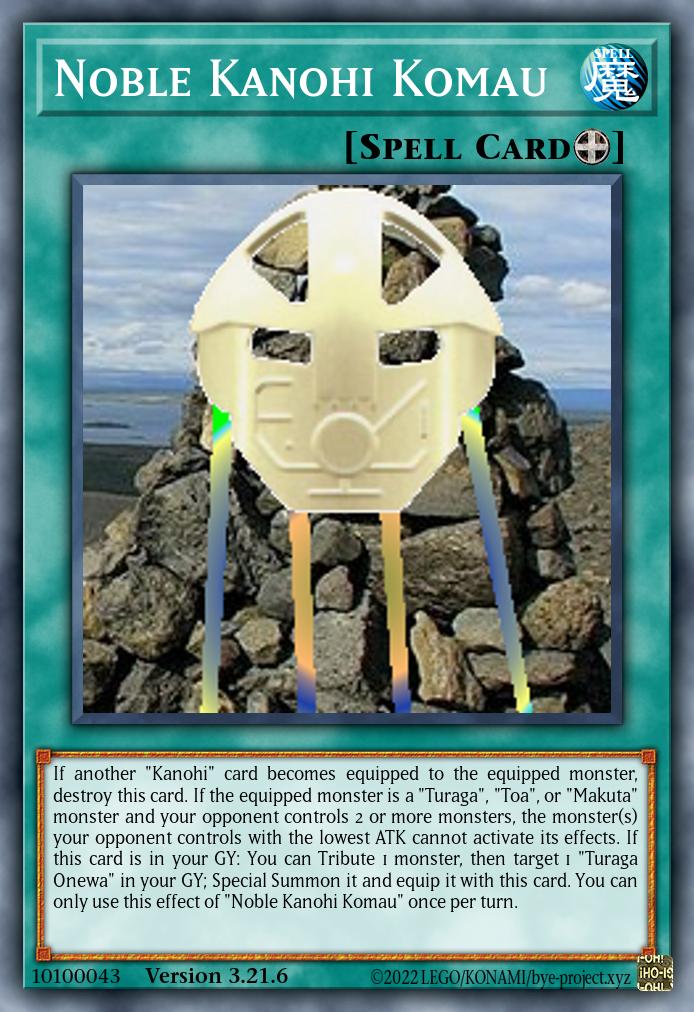
Noble Kanohi Komau
Equip SpellIf another “Kanohi” card becomes equipped to the equipped monster, destroy this card. If the equipped monster is a “Turaga”, “Toa”, or “Makuta” monster and your opponent controls 2 or more monsters, the monster(s) your opponent controls with the lowest ATK cannot activate its effects. If this card is in your GY: You can Tribute 1 monster, then target 1 “Turaga Onewa” in your GY; Special Summon it and equip it with this card. You can only use this effect of “Noble Kanohi Komau” once per turn.
Turaga Onewa is meant to be one answer to this question. On having an EARTH monster summoned next to his arrow, he will immediately bring back a banished EARTH Warrior, which transforms the cost to summon Tokens into one more monster on the field. Of course, the summoning restriction means you can’t use all this field presence to just continue Link Summoning, so you’ll need to make sure you have a Tuner or something to really benefit here. One thing I considered doing for a bit was letting Onewa turn the monster he brings back into a Tuner, but what bothered me there was that it would potentially allow you to just use the same Gouki-based deck I had for Onu-Koro and still reliably fulfill the requirement of two Extra Deck summoning methods. Kind of runs counter to the separation I’m trying to achieve, although it would technically be a distinct strategy even if it uses the same cards as its vehicle.
Since you can’t always expect to draw Po-Koro and do the setup that way, Onewa’s first effect provides another way to banish stuff, and comes with a lore gimmick to its math representing his famous ability to resolve disputes fairly. On top of the perfectly neutral action of putting a monster from the GY back into the hand and banishing a card from the hand, it gives a draw to only the player who is currently behind in advantage, so it works out to +1 if that’s you and -1 if it’s your opponent (and neutral in every other case). Fair.
The Kanohi Komau has mind control as its power, and with the original version back in 2014, I was quick to make the obvious association and write an effect that takes control of an opponent’s monster. In hindsight, that’s a bit above the intended powerlevel of Noble Kanohi, so the redesign instead turns it into a passive effect of using mind control to “stun” the weakest enemy (in terms of ATK, because unfortunately there isn’t a willpower stat that could be used for perfect accuracy). This fits well with the Huna and Rau as an effect that just inconveniences the opponent a bit and forces them to play around it, and for Po-Koro’s particular strategy of building a board with Extra Deck monsters, it makes a reasonable addition to the usual negates and disruptions you want to set up. Tributing a Sculpture Token to revive Onewa together with the Komau is something that happened semi-frequently during testing.
One noteworthy aspect of the way Onewa brings back banished monsters is that they are free to use their effects, so we can gain further advantage by using targets with beneficial effects on Special Summon. This is the niche our first Po-Matoran plays into.
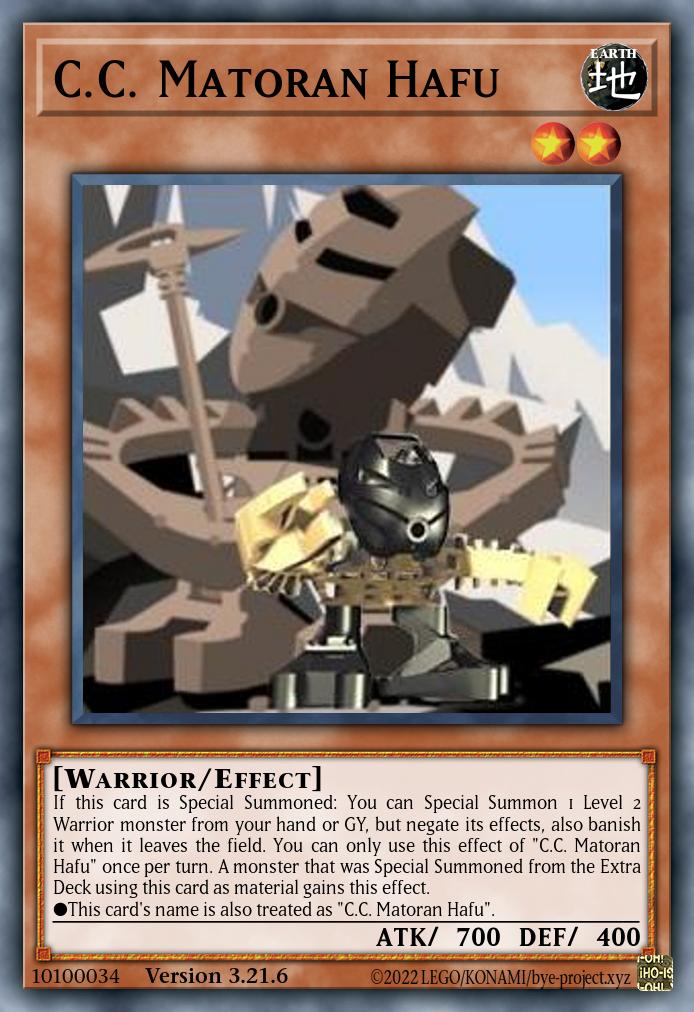
C.C. Matoran Hafu
Effect MonsterLevel 2 | EARTH Warrior | ATK 700 / DEF 400If this card is Special Summoned: You can Special Summon 1 Level 2 Warrior monster from your hand or GY, but negate its effects, also banish it when it leaves the field. You can only use this effect of “C.C. Matoran Hafu” once per turn. A monster that was Special Summoned from the Extra Deck using this card as material gains this effect.
●This card’s name is also treated as “C.C. Matoran Hafu”.
Both of Hafu’s effects are essentially retained from his original incarnation, with a bit of adjustment. Being the master carver, he’s fully meant to facilitate more Extra Deck summoning and brings back another Level 2 Warrior (could be another Matoran, or a generic Tuner like Junk Anchor to enable Synchros) when Special Summoned. His other ability is crafting “Hafu originals” in his own likeness, meaning whatever uses him as material inherits his name. This mainly has applications in a dedicated “C.C. Matoran” strategy, where members of the archetype get a range of neat benefits. Here, it’s really just a cute gimmick that barely comes up.
The other thing about Onewa is that you need to Special Summon an EARTH monster to the correct zone so he triggers, which is also something the villagers can assist with.
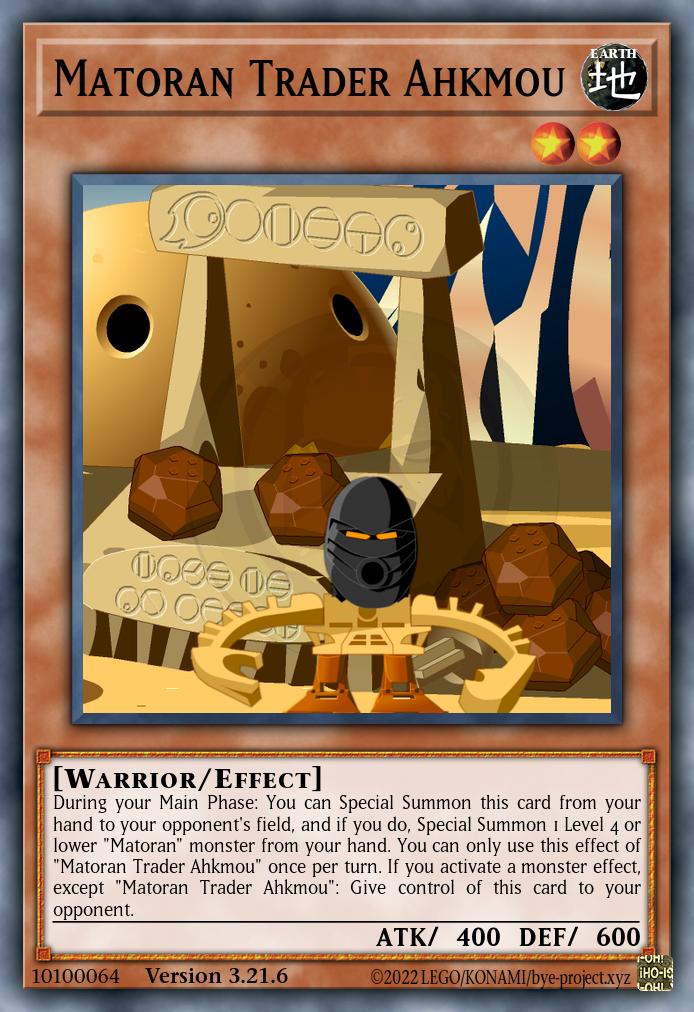
Matoran Trader Ahkmou
Effect MonsterLevel 2 | EARTH Warrior | ATK 400 / DEF 600During your Main Phase: You can Special Summon this card from your hand to your opponent’s field, and if you do, Special Summon 1 Level 4 or lower “Matoran” monster from your hand. You can only use this effect of “Matoran Trader Ahkmou” once per turn. If you activate a monster effect, except “Matoran Trader Ahkmou”: Give control of this card to your opponent.
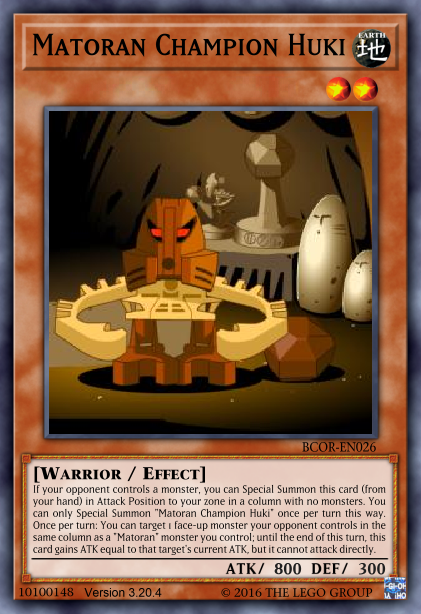
Matoran Champion Huki
Effect MonsterLevel 2 | EARTH Warrior | ATK 800 / DEF 300If your opponent controls a monster, you can Special Summon this card (from your hand) in Attack Position to your zone in a column with no monsters. You can only Special Summon “Matoran Champion Huki” once per turn this way. Once per turn: You can target 1 face-up monster your opponent controls in the same column as a “Matoran” monster you control; until the end of this turn, this card gains ATK equal to that target’s current ATK, but it cannot attack directly.
Ahkmou, the perfectly loyal and honest businessman who is definitely not in cahoots with evil or anything, puts himself on the opponent’s field from your hand to allow you a free Special Summon of a Matoran. Not only does this offer an additional way to start and extend combos, it also protects you from handtraps that require an empty field, which is further enhanced by his second effect to betray his current controller whenever they activate another monster effect (including pretty much all other handtraps). Just two things to note about this: It’s a trigger effect and thus won’t happen until after the chain with the monster effect has resolved, and it’s not once per turn in any way, so he might just betray you back right after joining your side.
Koli champion Huki is a very easy Special Summon going second, placing himself precisely in front of any open spots in your opponent’s lineup – ideally one of the two zones Onewa points to. Even going first, you can actually set up his Special Summon with Ahkmou, so that’s potentially neat. Furthermore, as a highly competitive pro athlete, he will rise to any challenge directly facing him or his fellow Matoran, gaining enough ATK to hit over any monster in the same column.
If you’re familiar with the structure of these Koro strategies, you already know that the last piece of the puzzle is the village’s Toa, but in the case of such an Extra Deck focused theme, a Main Deck boss is a bit of an odd fit. Still, I feel like I managed to give him an effect that provides a fair level of utility.
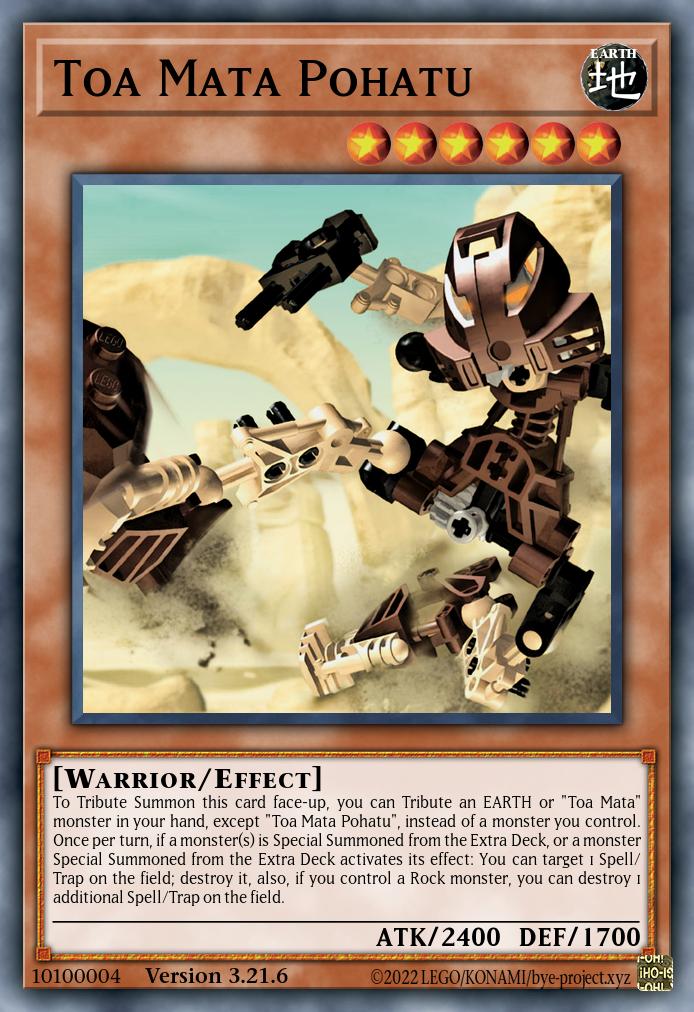
Toa Mata Pohatu
Effect MonsterLevel 6 | EARTH Warrior | ATK 2400 / DEF 1700To Tribute Summon this card face-up, you can Tribute an EARTH or “Toa Mata” monster in your hand, except “Toa Mata Pohatu”, instead of a monster you control. Once per turn, if a monster(s) is Special Summoned from the Extra Deck, or a monster Special Summoned from the Extra Deck activates its effect: You can target 1 Spell/Trap on the field; destroy it, also, if you control a Rock monster, you can destroy 1 additional Spell/Trap on the field.
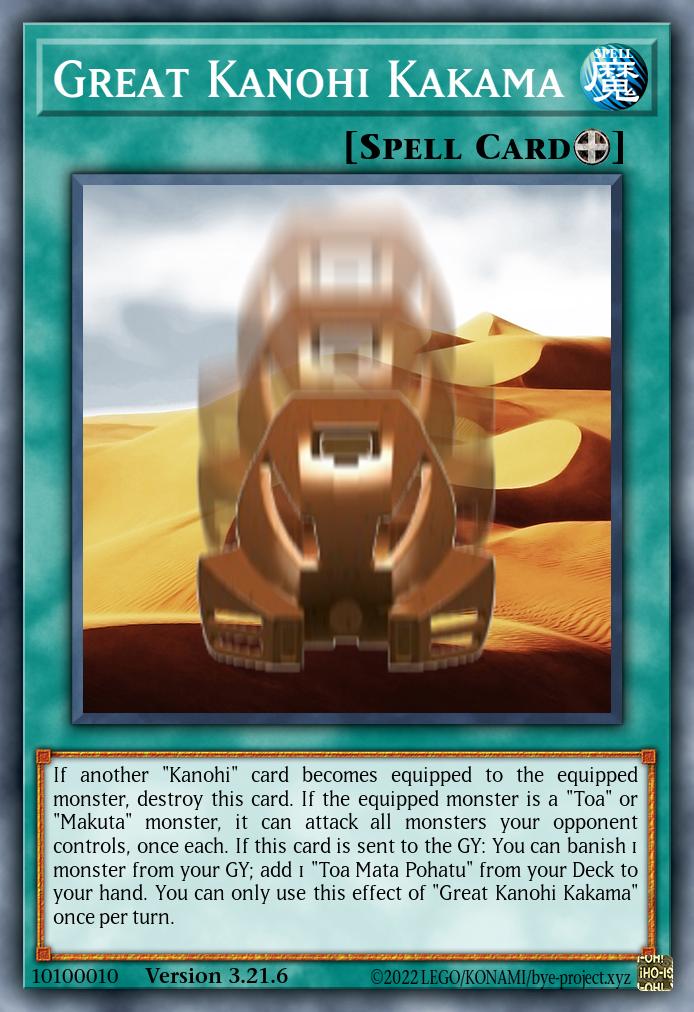
Great Kanohi Kakama
Equip SpellIf another “Kanohi” card becomes equipped to the equipped monster, destroy this card. If the equipped monster is a “Toa” or “Makuta” monster, it can attack all monsters your opponent controls, once each. If this card is sent to the GY: You can banish 1 monster from your GY; add 1 “Toa Mata Pohatu” from your Deck to your hand. You can only use this effect of “Great Kanohi Kakama” once per turn.
What Pohatu brings to the table is Spell/Trap removal, and to match Po-Koro, he does it whenever monsters are Special Summoned from the Extra Deck. Furthermore, since we don’t want him to be useless after you have already built your board, he has a secondary trigger off the effect activations of Extra Deck monsters. Do note, however, that this is a trigger effect and not a quick effect, meaning it will activate on a separate chain only after the triggering effect has resolved.
The mental image behind this S/T destruction is destroying stuff by kicking a rock at it, and so it’s fitting to have a bonus effect if you actually happen to have a Rock monster (e.g. a Sculpture Token or a Suva). I went with the ricochet idea here, which means you get an additional (non-targeting) S/T destruction in that case. Seeing how the law of creative heroic thinking permits using the environment to harm enemies indirectly, letting the second destruction affect monsters as well may be a viable option, though in that case it would probably be fair to also destroy your Rock monster as a downside.
Finally, the Kanohi Kakama, Great Mask of Speed, lets the equipped monster move fast enough to attack everything in a single Battle Phase, essentially letting you use Pohatu to clear out all the monsters after using his effect to clear up to 2 backrow. This is a scenario that occured exactly 0 times during the test circuit, but hey, theoretically it sounds useful.
Sample Deck
I couldn’t think of any existing EARTH Warrior archetype that focuses mainly on Extra Deck spam while also adhering to the rule of using 2+ summoning methods, so instead of using such a thing as a starting point I just had to jam some appropriate enginges together with Po-Matoran and hope it does what I want. Because of this, the sample deck explanation is a bit more elaborate than usual here.
The route I took to fulfill the 2 summoning method requirement was Link + Synchro, since they’re much easier to pull off than Fusion and immediately put banishable monsters into the GY unlike Xyz. In order to get access to the necessary Tuners, I picked Junk monsters as the EARTH Warrior core: Forward as a free Special Summon to start making Onewa, Anchor as a Tuner that also happens to be a Level 2 Warrior for Hafu, Converter as another Level 2 Warrior who does both searching and setup for Synchron (who is unfortunately not EARTH, but still good), and Servant as a free Special Summon whenever I have any of the others out. For the actual Matoran, we have just one Hafu (he only triggers on Special Summon, so having him in the hand isn’t the greatest), three Taipu because free Special Summon going first (not a Po-Matoran, but since the Chronicler’s Company are meant to work together, I figured there was no way to avoid synergy through the shared attribute in this case), three Ahkmou for the same reason, and two Huki since he’s mainly good going second. Thanks to Taipu’s presence, Hafu’s name change actually matters occasionally, by still letting you attack with some of your monsters from the Extra Deck after you summoned Taipu. The remaining EARTH Warriors are one Super Agent as an unreliable Special Summon and potential Spell/Trap remover, and Pohatu as your main Spell/Trap remover, Kakama search target, and Suva enabler.
Additional Tuners to get us consistent Synchro access are Adamancipator Researcher, whose Special Summon from the hand is enabled by Po-Koro’s Tokens, and Plaguespreader Zombie because this deck has a few garnets we’d like to put back if we draw them.
The Spells can be quickly summarized as Kanohi, searchers, and ways to Special Summon to Onewa’s zone (most interestingly Word Legacy Succession, which does exactly that). And of course, we have the Dragoon package I put in to celebrate the complete freedom of Extra Deck choices and then proceeded to regret immensely because it’s so powerful and easy to make that it ends up distracting from the actual point of the Deck. Which is why I ended up intentionally siding it out for the rest of the match every time I won a duel during testing, even when I didn’t actually use it.
The Extra Deck could probably be filled a million different ways, but what I settled on after trying a lot of variations is:
- Onewa to get free monsters.
- Amaja-Nui to get additional Tokens by linking off Onewa.
- Isolde to trigger the Kakama’s search and to get Hafu or Junk Anchor (either as followup to Onewa or as an alternative if you don’t have the setup to trigger him).
- Halquifibrax because it has just as much synergy with Po-Koro as it did with Linkross.
- Desert Locusts to summon via Halq for a discard while potentially triggering Onewa.
- Link Spider because it can be made with a single Sculpture Token.
- Avramax as a big dude you can make e.g. with Onewa and Isolde.
- Herald of the Arc Light as an easy banishing floodgate and negate.
- Jiujiu as an indestructible removal tool.
- Marcher and Integrator so you can get to Jiujiu from Researcher and two Sculpture Tokens while drawing in the process.
- Dragite as a negate and removal tool.
- Quandax to make Dragite while getting a WATER into the GY so the negate is turned on.
- Verte Anaconda plus Dragoon in case you mess up the actual combo but feel like winning anyway.
Finally, the side deck is just a pile of EARTH staples and cards that are really good in some situations, plus options to fill the Extra Deck slots left open when removing the Dragoon stuff (Accesscode as an alternate boss, Geonator Transverser as an alternate Link you can make with random monsters).
To see all this in action, continue right on.
Best of Test
Conclusion
Po-Koro decks encourage Special Summoning from the Extra Deck and excel at providing a bunch of material to do so. However, lacking dedicated boss monsters of its own and having some tricky requirements and restrictions on the Field Spell, the success of the strategy is very much dependent on what other cards you combine it with, perhaps more so than any of the other villages. Also, the need to have cards to both make Onewa in the Extra Monster Zone and trigger him with an additional Special Summon can be quite the hurdle to consistency.

